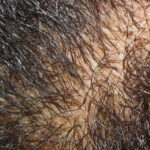Who doesn’t want a great head of hair, one that women will love to run their fingers through? To have that hair, you need to start with a healthy scalp. Even thinning hair looks more inviting if you have a healthy scalp. One of the main reasons for dry, brittle hair is a dry scalp. If you know the causes of a dry scalp, you can learn how to treat it, and improve the look and texture of your hair.
Dr. Marta Rendon, the founder and medical director of the Dermatology and Aesthetic Center in Boca Raton, Fla., and the Global Celebrity Dermatologist for Head & Shoulders, states, “Dry scalp occurs when the hair strand exiting the scalp is not being lubricated by sebum produced by the sebaceous gland. The sebaceous gland, also known as the oil gland, gives hair shine and luster; and when there is inadequate lubrication, the hair is denied essential oil.” Without that oil, you’ll have a dry scalp. Some other possible causes of dry scalp, according to Dr. Rendon, are diseases such as seborrheic dermatitis, scalp psoriasis, and atopic dermatitis of the scalp.
Your scalp, like the rest of your skin, is always shedding old dead cells so that new cells can grow. An article in Men’s Fitness Magazine says that the shedding and renewing process takes about a month when the scalp is healthy; when the scalp isn’t healthy, it can happen in a week, and may result in dandruff. Dr. Rendon tells us “cold temperatures and low humidity, a reaction to harsh chemicals, or a buildup from hair products can interrupt this natural exfoliating process.” That buildup can clog hair follicles, where the sebaceous glands are located, and stop the production of sebum. She adds that dandruff isn’t necessarily the same as a dry, flaky scalp, however. If you feel that your scalp is flakier than dryness alone would cause, check with a dermatologist to see if you do have dandruff.
The Men’s Fitness article states that regular shampooing with a gentle, hydrating shampoo can both remove the buildup of products and help keep your scalp from drying out by unblocking the sebaceous gland, located at the base of the hair follicle. It also suggests rinsing your hair with cool water, and if you use a blow dryer, using it at the lowest setting and keeping it at least a foot away from your head. Heat can also dry out your scalp.
A WebMD.com article advises that a healthy diet with two to three servings of protein daily, along with plenty of water, can help keep your scalp healthy from the inside out. The Web site also advises use of a cream rinse (be sure to thoroughly rinse it out with lukewarm to cool water to avoid buildup), and using a wide-tooth comb rather than a narrow-tooth comb or a brush. These steps, along with protecting your scalp from overexposure to the sun, will aid in maintaining a healthy scalp.
A last few tips from Dr. Rendon and other sources for treating a dry scalp and keeping dryness from coming back: Avoid scratching a dry scalp, because scratching will make your scalp even more dry and itchy; keep your scalp clean and hydrated; avoid product buildup on your hair and scalp; rinse with lukewarm to cool water; and eat a healthy diet.



